There’s something undeniably powerful about the taste of nostalgia. A single bite—or even just the memory of one—can transport us back to childhood lunchboxes, Saturday morning cartoons, or after-school snacks devoured straight from shiny foil wrappers. For anyone who grew up in the 1970s or 1980s, food was more than just sustenance—it was pure joy wrapped in vibrant packaging, pumped full of sugar, and often delivered by cartoon mascots with catchphrases we’ll never forget.
Back then, grocery store aisles were bursting with now-extinct delights: neon-colored drinks, chocolate bars that stretched for miles, cereals that turned milk into magic, and snacks that proudly wore their artificial flavors like a badge of honor. Whether it was a frozen pudding pop on a hot summer day or a peanut butter-flavored spread with a funky name, these foods weren’t just trendy—they were iconic. And though many were discontinued due to changing tastes, corporate mergers, or health concerns, their legacies live on in our cravings.
Today, some of these edible relics feel like urban legends—did we really drink apple soda? Was there actually a cereal shaped like the letter T? And yes, we’re still trying to recreate that gooey center from those fudge-stuffed cookies. These vanished treats represent a time when food was fun, quirky, and unapologetically indulgent.
So whether you’re a Gen Xer, an elder millennial, or just a curious foodie, get ready to stroll down memory lane. We’ve rounded up 27 discontinued foods from the ’70s and ’80s that still live rent-free in our minds—and if they ever came back, you can bet we’d be first in line. Hungry for a retro snack time revival? Let’s dive into the crave-worthy classics we’ll never forget.
1. Hi-C Ecto Coolers
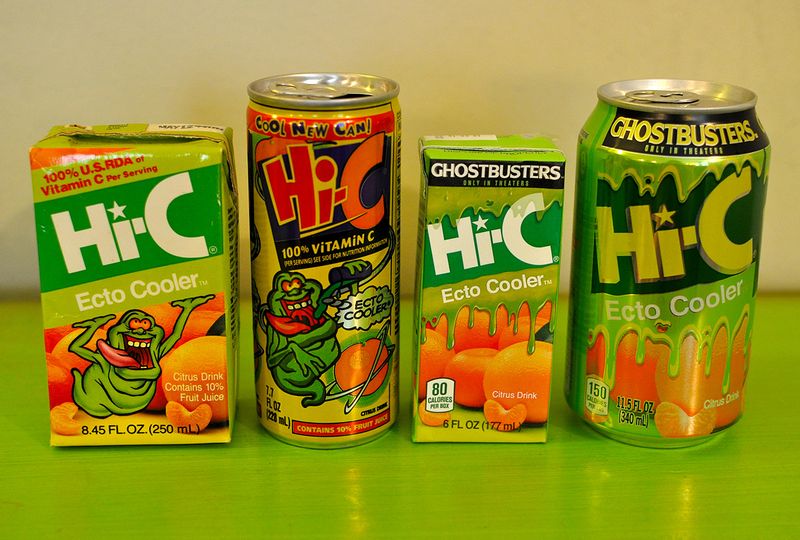
The slime-green citrus drink that captured kids’ imaginations nationwide wasn’t just another juice box. Launched in 1987 to promote “The Real Ghostbusters” cartoon, this tangy, electric-green beverage became a cultural phenomenon that outlasted the show it was created to advertise.
With its unique sweet-tart flavor and memorable neon color, Ecto Cooler became the crown jewel of school lunchboxes everywhere.
Though officially discontinued in 2001, fan demand prompted several limited revivals, including one for the 2016 Ghostbusters reboot.
2. Keebler Fudge Magic Middles

Imagine biting into what looks like an ordinary shortbread cookie only to discover a hidden treasure of warm, gooey chocolate fudge inside. That was the delightful surprise of Magic Middles – a perfect balance of buttery cookie exterior and rich chocolate center.
Keebler’s elves outdid themselves with this 1980s creation. The unique dual-texture experience created devoted fans who still petition for their return decades after disappearing from shelves.
No modern cookie has quite captured the same magical formula of crumbly exterior giving way to that perfect chocolate center.
3. Fruit Corners Fruit Wrinkles
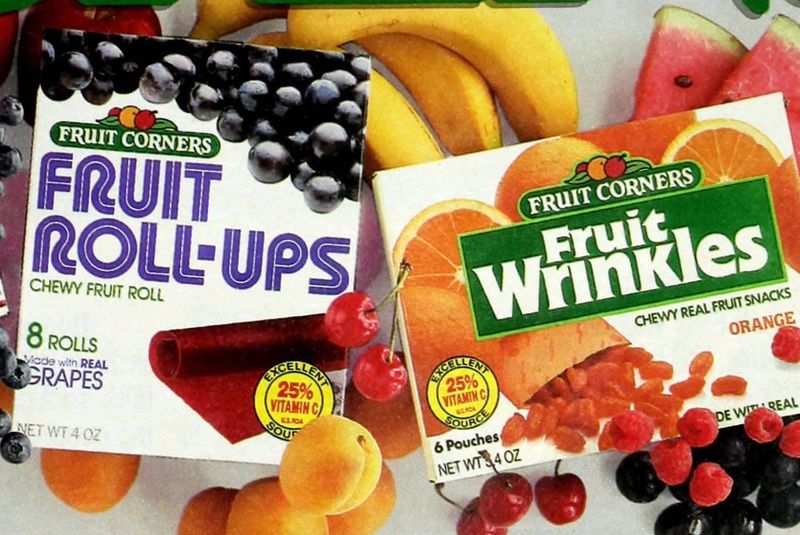
Before Fruit Roll-Ups dominated the fruit snack scene, there were Fruit Wrinkles – those intensely flavored, chewy little morsels that came in a pouch and packed a serious punch.
Each wrinkly piece delivered concentrated fruit flavor in an oddly satisfying texture that was both chewy and slightly firm. General Mills introduced these as part of their Fruit Corners line in the 1980s.
Kids loved their portable nature and parents appreciated the fruit-based marketing. Despite having loyal fans, these wrinkly treats disappeared by the early 1990s, overshadowed by their flatter, more successful fruit snack cousins.
4. Jell-O Pudding Pops
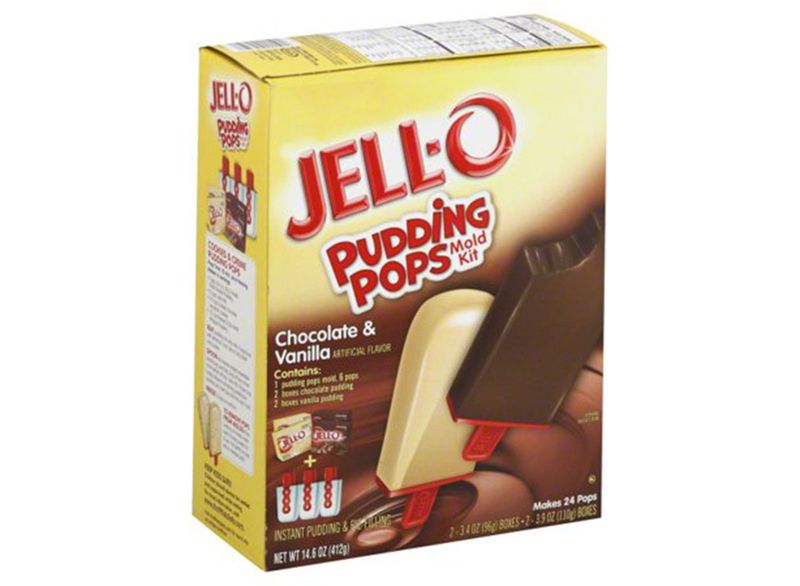
Summer afternoons in the ’80s weren’t complete without the unique texture of a Jell-O Pudding Pop. Unlike traditional ice cream treats, these frozen pudding bars had a velvety, creamy consistency that melted differently in your mouth – somewhere between ice cream and actual pudding.
Available in chocolate, vanilla, and swirl varieties, they achieved massive popularity through commercials featuring Bill Cosby.
The original version disappeared from freezers in the 1990s despite their devoted following. Later attempts to revive the brand never captured the exact texture and taste that made the originals so special.
5. Baron Von Redberry Cereal
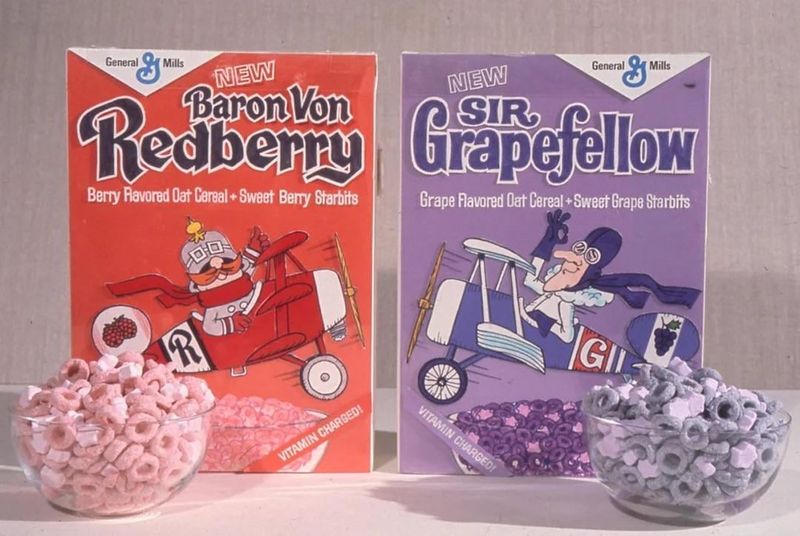
General Mills created cereal warfare in your breakfast bowl with Baron Von Redberry and his nemesis, Sir Grapefellow. The Baron’s red, berry-flavored cereal pieces were shaped like stars and packed a fruity punch that turned milk pink – a magical transformation for young eaters in the 1970s.
The marketing was genius: two aristocratic World War I flying aces battling it out for cereal supremacy. The Baron’s catchphrase “Baron Von Redberry is der berry goodest!” still triggers nostalgia for many 70s kids.
Despite its devoted following, this whimsical cereal vanished after just a few years, becoming a true cult classic.
6. Swanson TV Dinners
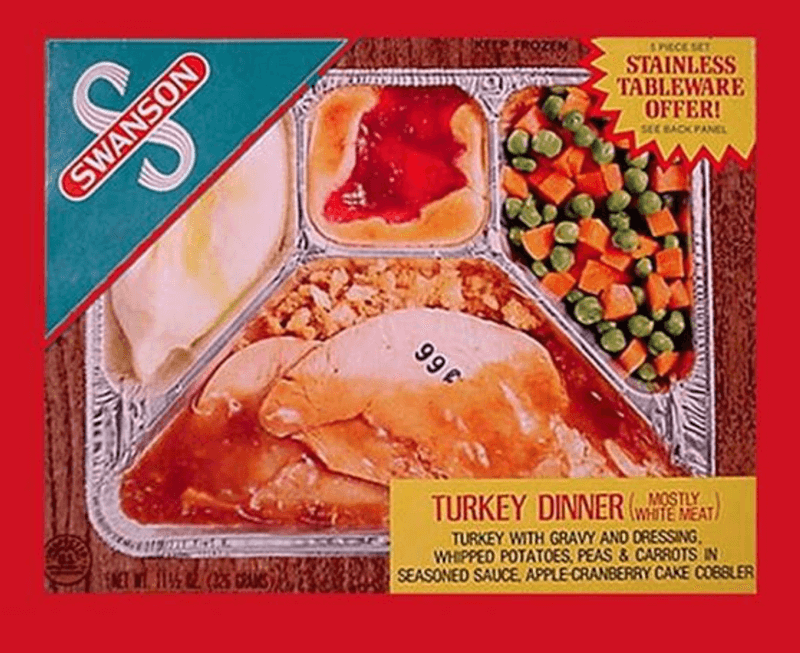
Nothing symbolized the changing American lifestyle of the 1970s quite like the iconic aluminum tray of a Swanson TV Dinner. These compartmentalized meals revolutionized dinnertime, allowing families to eat while watching their favorite programs without the fuss of cooking.
The classic foil tray with sections for meat, vegetables, and dessert (usually that signature cherry cobbler) became a cultural touchstone. Kids loved the novelty while parents appreciated the convenience.
While frozen dinners still exist, the original Swanson brand and their specific formula gradually disappeared, replaced by more health-conscious options and microwave-friendly packaging.
7. Hershey’s Bar None Candy Bar
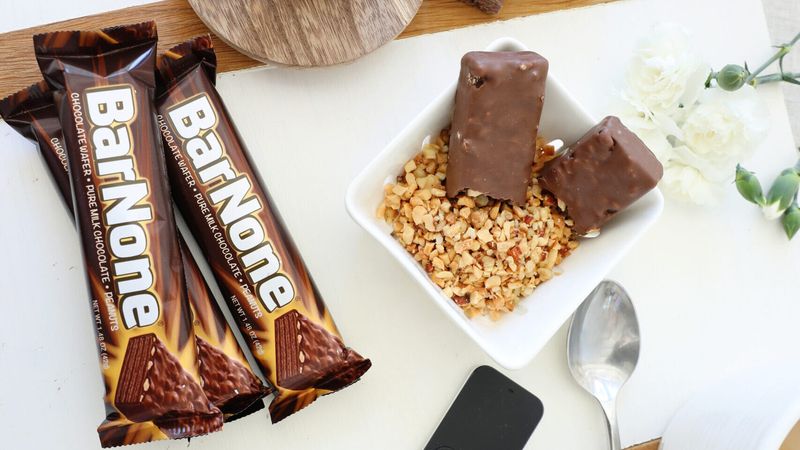
When Hershey’s introduced Bar None in 1987, they created something truly special – a sophisticated layered candy bar for grown-up tastes. The original featured chocolate wafers surrounded by chocolate cream, crushed peanuts, and a milk chocolate coating that created a perfect textural symphony.
Its name cleverly suggested nothing could compare to this unique combination. Bar None developed a passionate following through the late ’80s and early ’90s.
Hershey’s later reformulated it with caramel and a different shape before discontinuing it entirely in 1997, leaving fans to search for similar but never-quite-the-same alternatives ever since.
8. Nabisco Swiss Cheese Crackers
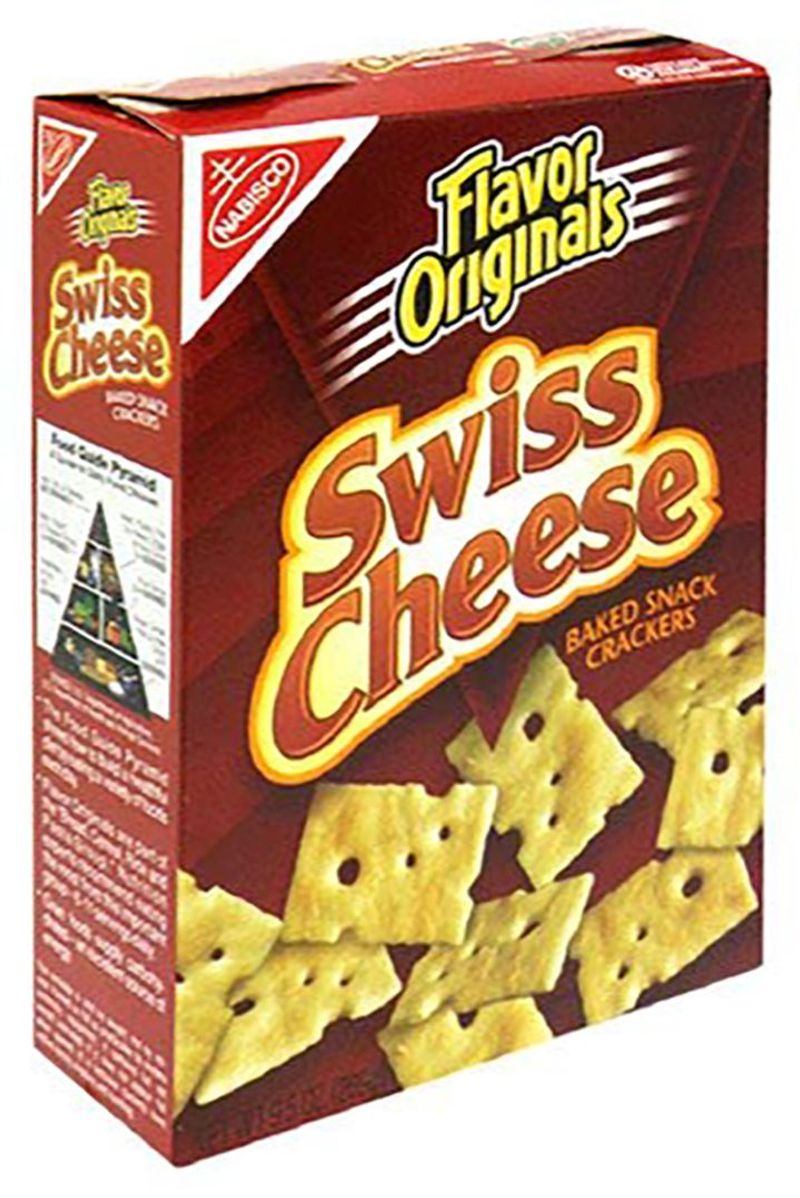
Long before fancy cheese-flavored snacks dominated grocery aisles, Nabisco’s Swiss Cheese Crackers offered something authentically different. These distinctive yellow crackers contained actual Swiss cheese baked right into the dough and featured the signature holes found in real Swiss cheese.
The crackers delivered a tangy, nutty flavor that was more sophisticated than processed cheese products. They made perfect after-school snacks or party appetizers throughout the late 1970s and early 1980s.
Despite their unique appeal, these crackers gradually disappeared from shelves, leaving a hole in the cracker aisle that fancy artisanal options have never quite filled.
9. Reggie! Bar
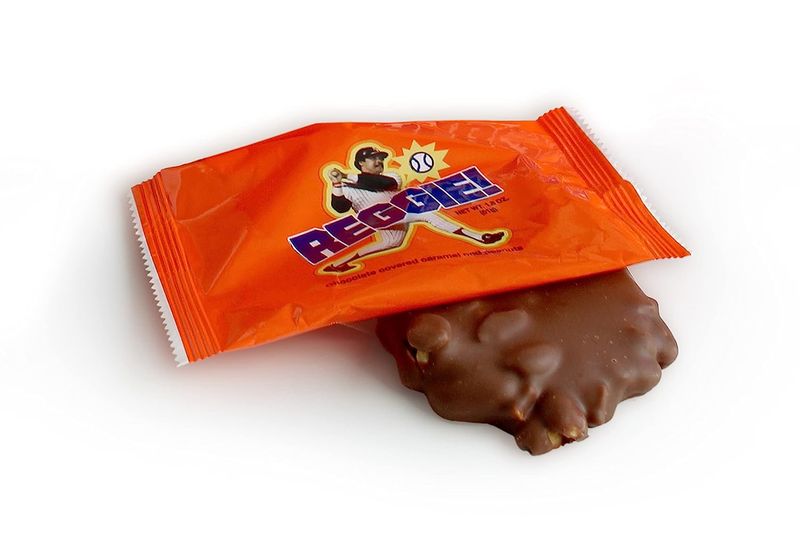
Baseball and candy merged perfectly in the Reggie! Bar – a round disc of caramel, peanuts and chocolate named after baseball superstar Reggie Jackson. When Jackson signed with the Yankees in 1976, Standard Brands created this sweet tribute that became part of sports history.
The marketing reached legendary status when the candy was handed out to 54,000 fans at Yankee Stadium on opening day 1978. When Jackson hit a home run, ecstatic fans threw thousands of Reggie!
Bars onto the field in celebration. The candy disappeared after a few years, but that moment of candy-throwing euphoria lives on in baseball lore.
10. Danka Toaster Snacks
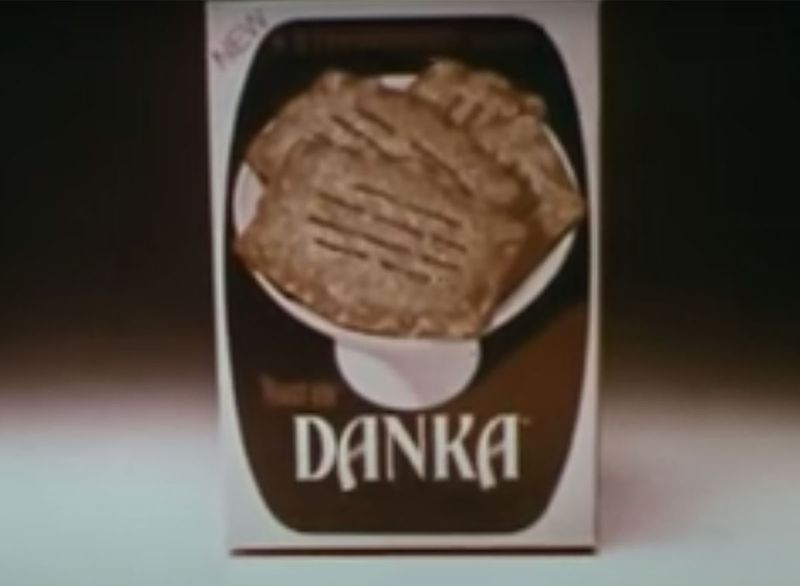
Danka Toaster Snacks were a short-lived but fondly remembered treat from the 1970s, known for their flaky pastry shells and savory, cheesy fillings.
Marketed as a quick, toaster-friendly alternative to traditional hot meals, they came in flavors like cheese and ham or pepperoni pizza, appealing to busy families and hungry kids alike. While similar in concept to Pop-Tarts, Danka leaned savory over sweet, delivering a warm, gooey center with every bite.
Despite their convenience and flavor, they quietly disappeared from shelves by the early ’80s, leaving behind a trail of nostalgia for those lucky enough to enjoy them fresh from the toaster.
11. PB Max Candy Bar
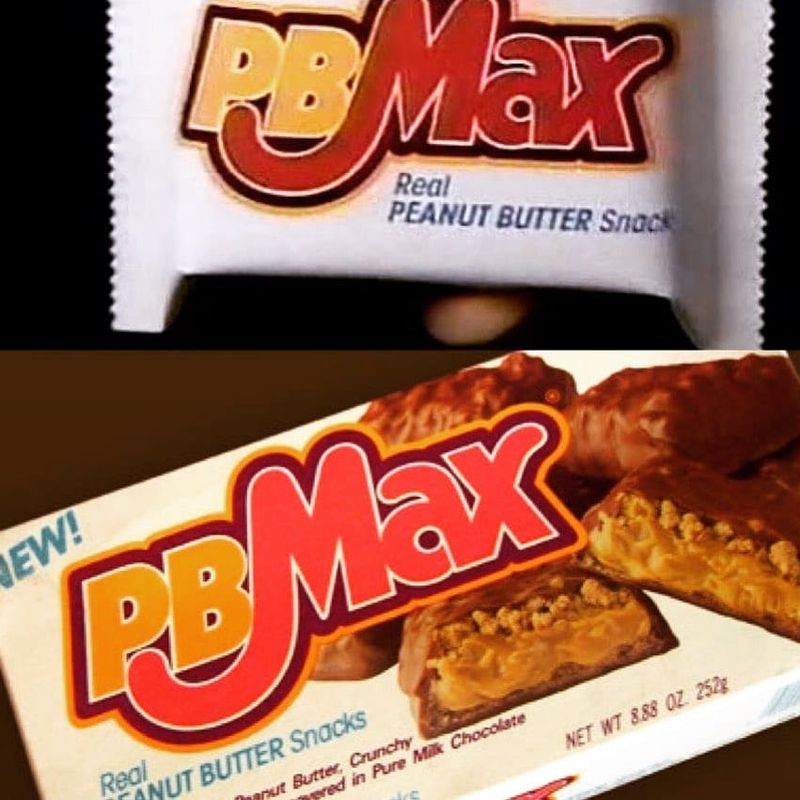
The PB Max wasn’t just another peanut butter candy – it was a textural masterpiece that deserved a longer shelf life. This substantial square featured a crunchy whole grain cookie base topped with creamy peanut butter and oats, all enrobed in milk chocolate.
Mars introduced this innovative treat in 1989, and it quickly became a $50 million success. What makes its discontinuation so baffling is that it was still highly profitable when axed in the mid-90s.
Legend has it the Mars family personally disliked peanut butter and discontinued it despite its popularity – a decision that continues to perplex candy enthusiasts to this day.
12. Koogle Flavored Peanut Butter
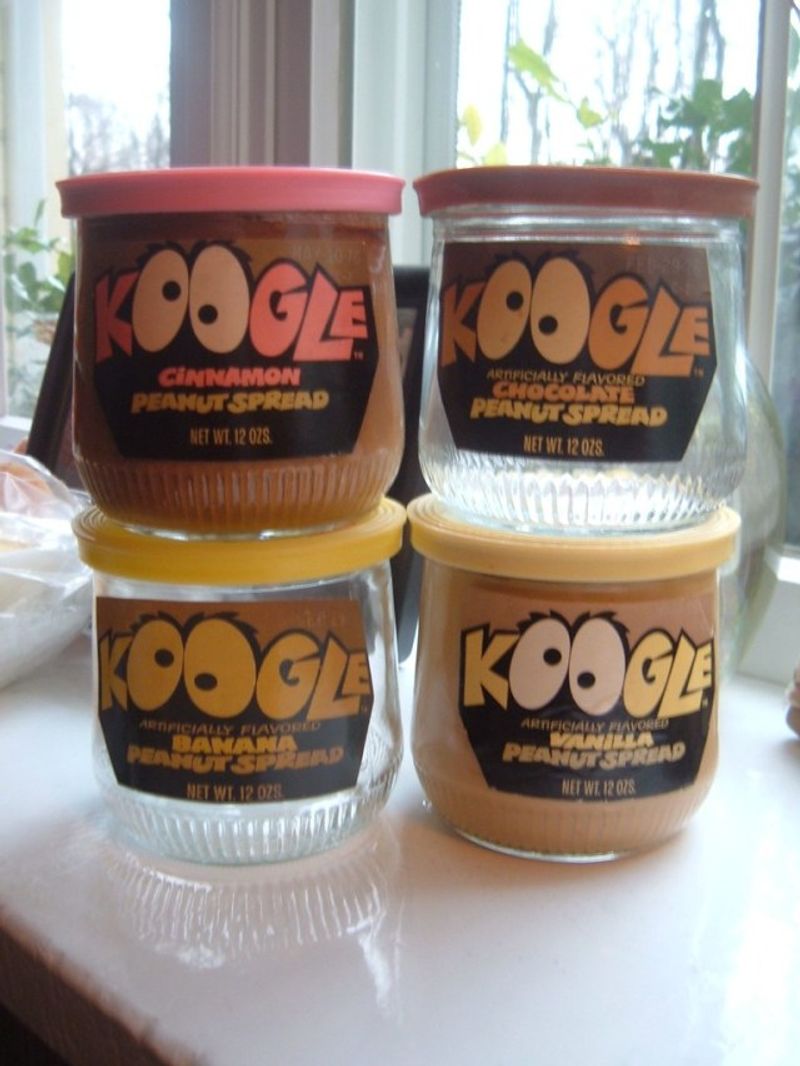
The 1970s were wild times – even for peanut butter. Koogle took ordinary peanut butter and transformed it into a psychedelic experience with flavors like chocolate, cinnamon, vanilla, and banana.
Kids couldn’t get enough of this groovy spread. The marketing was pure ’70s magic, featuring a puppet mascot with googly eyes who danced and sang the catchy jingle: “Peanut butter with a lively new taste, Koogle with the lively taste!”
This funky spread was perfect for creating unusual sandwiches or eating straight from the jar. Like many food innovations of the era, Koogle disappeared by the early 1980s, too beautiful and strange for this world.
13. Aspen Apple Soda
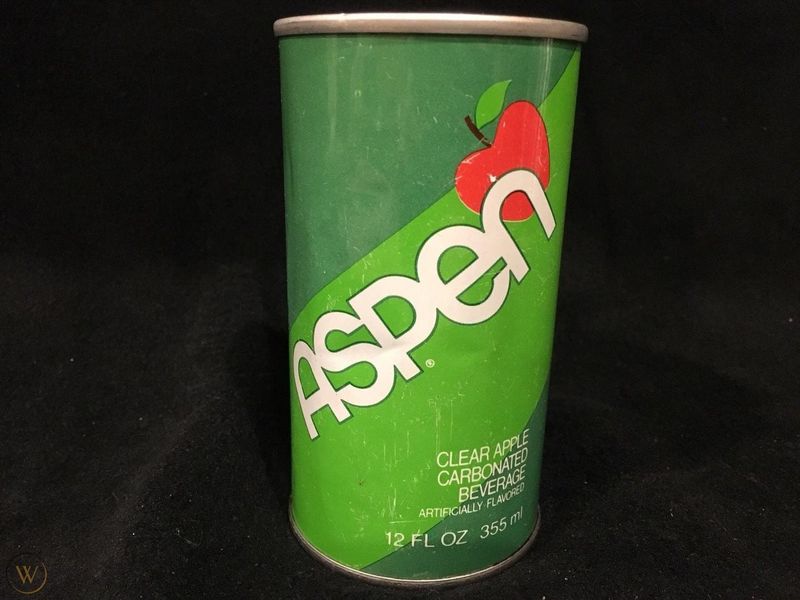
Before artisanal apple sodas became trendy, Pepsi created Aspen – a crisp, refreshing apple-flavored soda that briefly captured the market’s attention. Launched in 1978, this carbonated apple drink offered a lighter alternative to cola with its clean, tart flavor profile.
The marketing positioned Aspen as the perfect beverage for active, outdoorsy types, with commercials featuring mountain scenery and active young people. The distinctive green cans and bottles stood out on store shelves.
Despite initial popularity, Aspen disappeared by 1982, unable to carve a permanent niche in a cola-dominated market. Its brief existence left apple soda enthusiasts with few mainstream options for decades.
14. Fruit Brute Monster Cereal
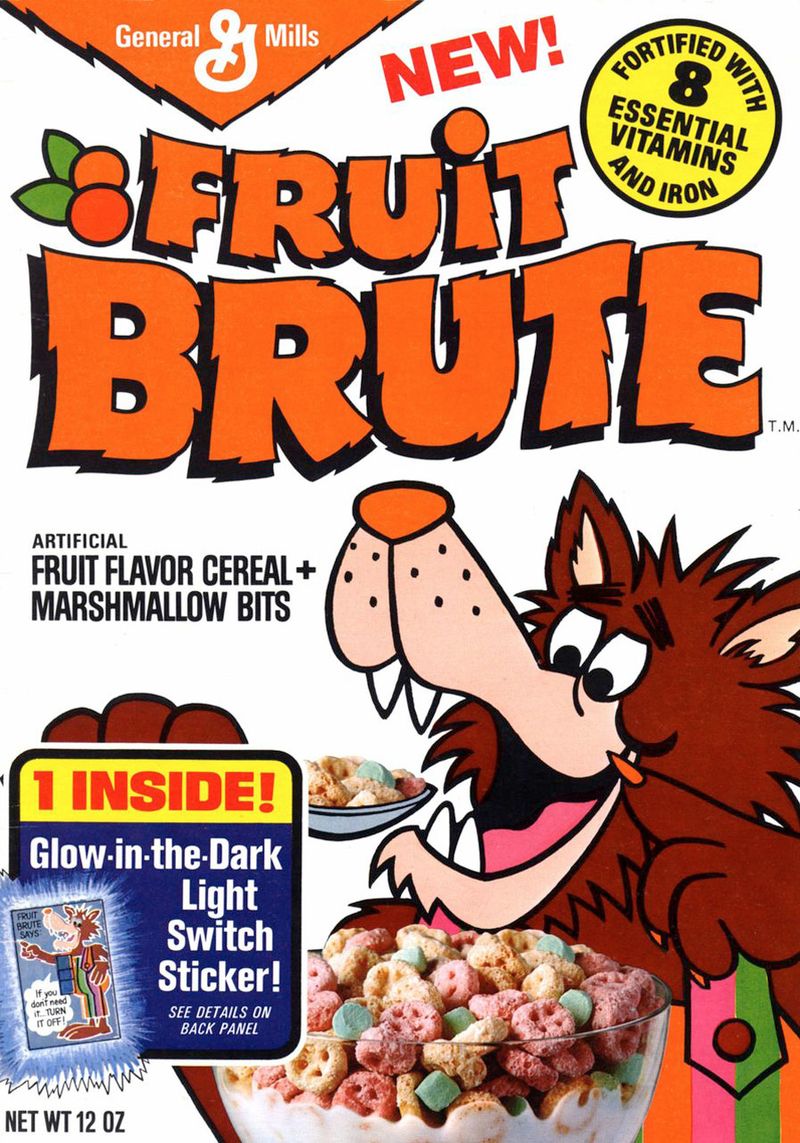
Howling onto breakfast tables in 1974, Fruit Brute joined General Mills’ monster cereal lineup alongside Count Chocula and Franken Berry. This werewolf-themed cereal featured fruit-flavored cereal pieces with lime marshmallows – a flavor combination that stood apart from its chocolate and strawberry siblings.
The box featured a colorful werewolf character wearing rainbow-colored overalls and howling about the cereal’s fruity flavor.
Despite having a dedicated following, Fruit Brute was the first monster to get the axe in 1982. The cereal achieved cult status after appearing in Quentin Tarantino films, leading to occasional limited resurrections during Halloween seasons.
15. Marathon Candy Bar
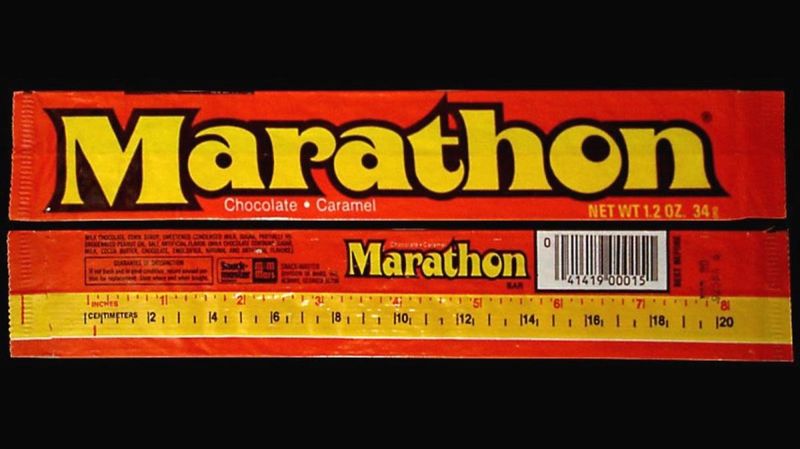
The Marathon bar solved a critical candy problem: how to make chocolate last longer. This ingenious treat featured braided caramel covered in chocolate, stretched to a remarkable 8 inches long – making it the perfect choice for kids wanting maximum candy enjoyment time.
Mars introduced Marathon in 1973 with memorable commercials featuring a race between the Marathon Man and the Quick Chew Rabbit. The packaging even included a ruler on the back to prove its impressive length.
After nearly a decade of stretchy success, Marathon disappeared in 1981. Though similar to today’s Cadbury Curly Wurly in the UK, American fans still mourn the original’s perfect chocolate-to-caramel ratio.
16. Hostess Chocodiles
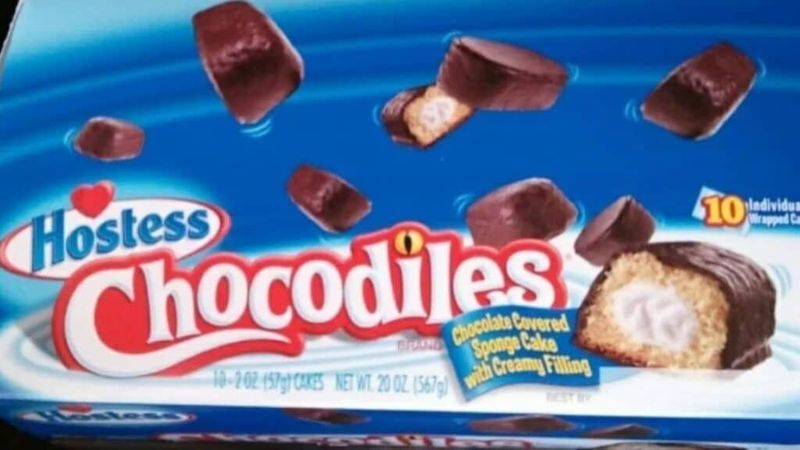
Imagine a Twinkie dressed up for a fancy chocolate party – that’s essentially what Chocodiles were. These chocolate-covered Twinkies created a perfect marriage of the familiar cream-filled sponge cake with a rich chocolate coating that added another dimension of sweetness and texture.
Originally introduced in the 1970s, Chocodiles featured a cartoon crocodile mascot named Chauncey. While they were available nationwide at first, they eventually became primarily a West Coast treat, making them legendary and sought-after in other regions.
After disappearing from stores, they’ve made occasional comebacks, but many fans insist the recipe isn’t quite the same as the original.
17. Nabisco Cheese Tid-Bit
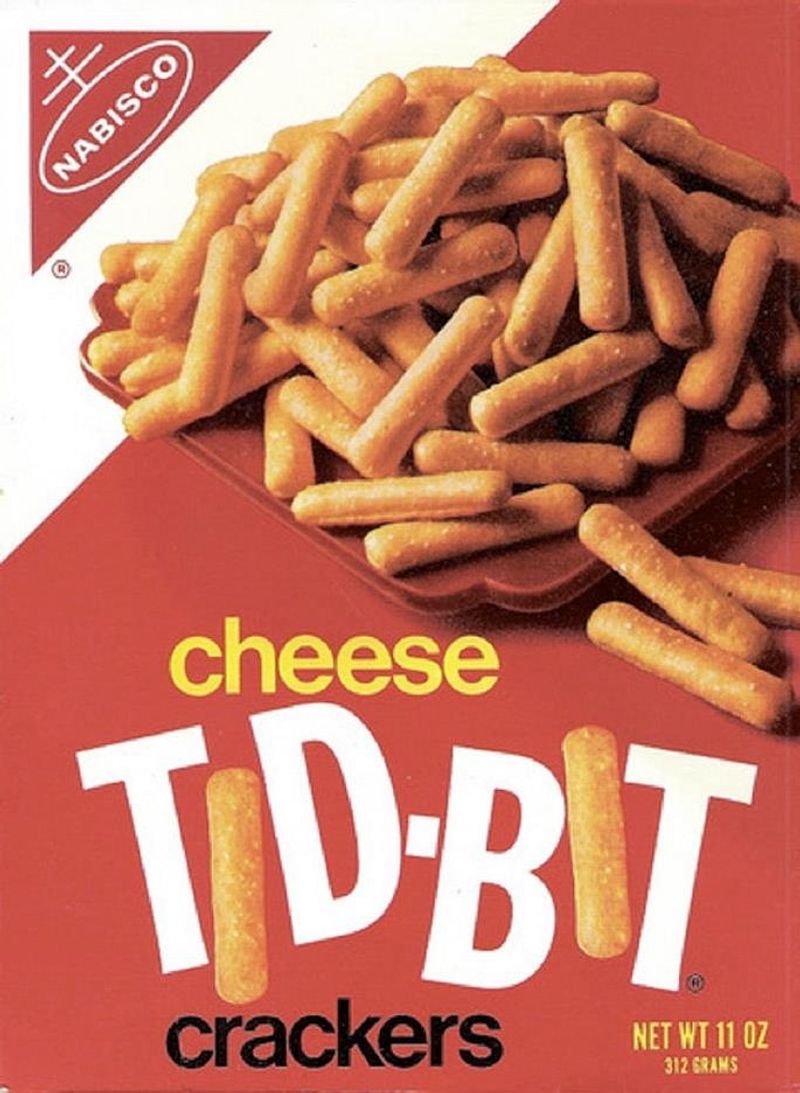
Before Cheez-Its dominated the cheese cracker market, Nabisco’s Cheese Tid-Bits were the gold standard for sharp cheddar flavor in a crunchy package. These small, rectangular crackers packed an intense cheese punch that made them irresistible for snacking.
Introduced in the 1960s, they remained popular through the 1970s. The crackers came in a distinctive red box with yellow lettering that stood out on pantry shelves.
Though they disappeared by the late 1980s, their legacy lives on in the countless cheese crackers that followed. Many connoisseurs still insist Tid-Bits had a sharper, more authentic cheese flavor than modern alternatives.
18. Nintendo Cereal System
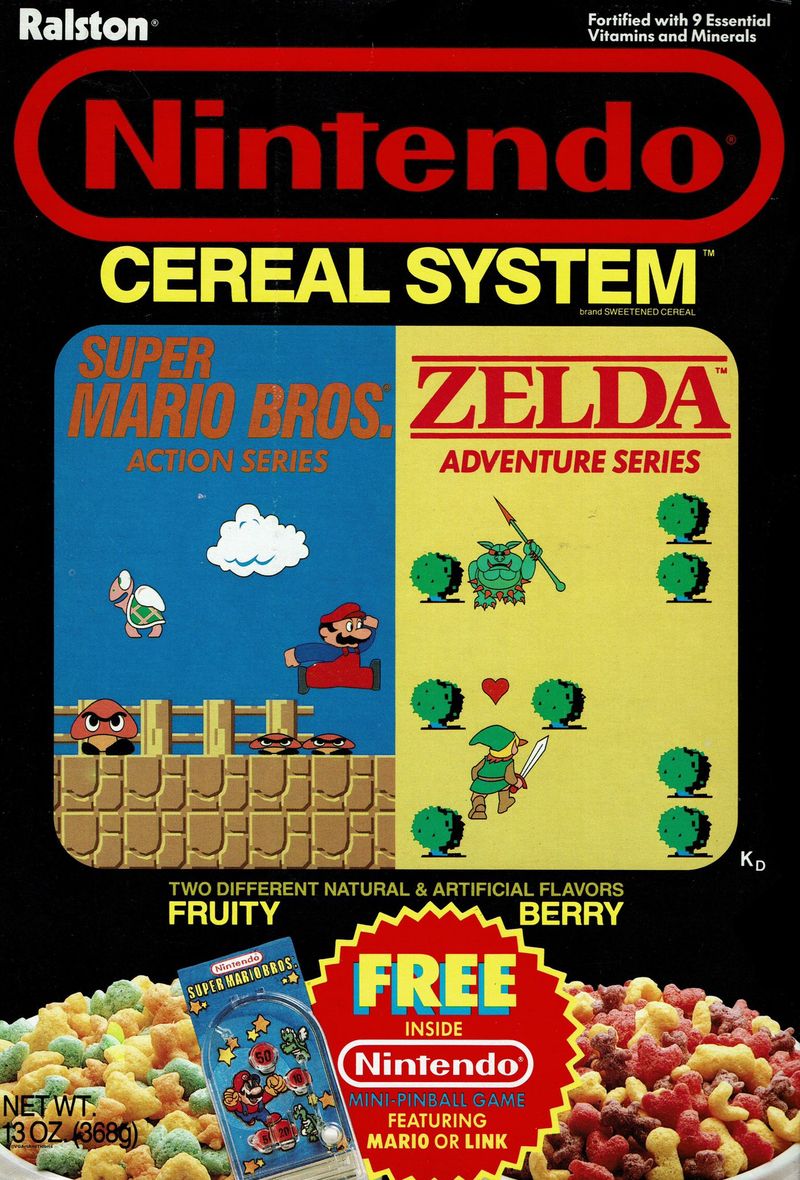
When breakfast met video games in 1988, the result was pure marketing genius – the Nintendo Cereal System. This innovative cereal came in a box divided into two separate bags: one side featured Mario-themed berry-flavored cereal pieces, while the other contained Zelda-inspired cherry-flavored bits.
Each side included fruity marshmallows shaped like video game items – stars, hearts, and other power-ups. The box itself became a collector’s item with Nintendo gameplay tips and mini-comics on the back.
Despite the massive popularity of Nintendo, the cereal lasted less than a year before disappearing, making it one of the most sought-after cereal collectibles today.
19. Banana Frosted Flakes
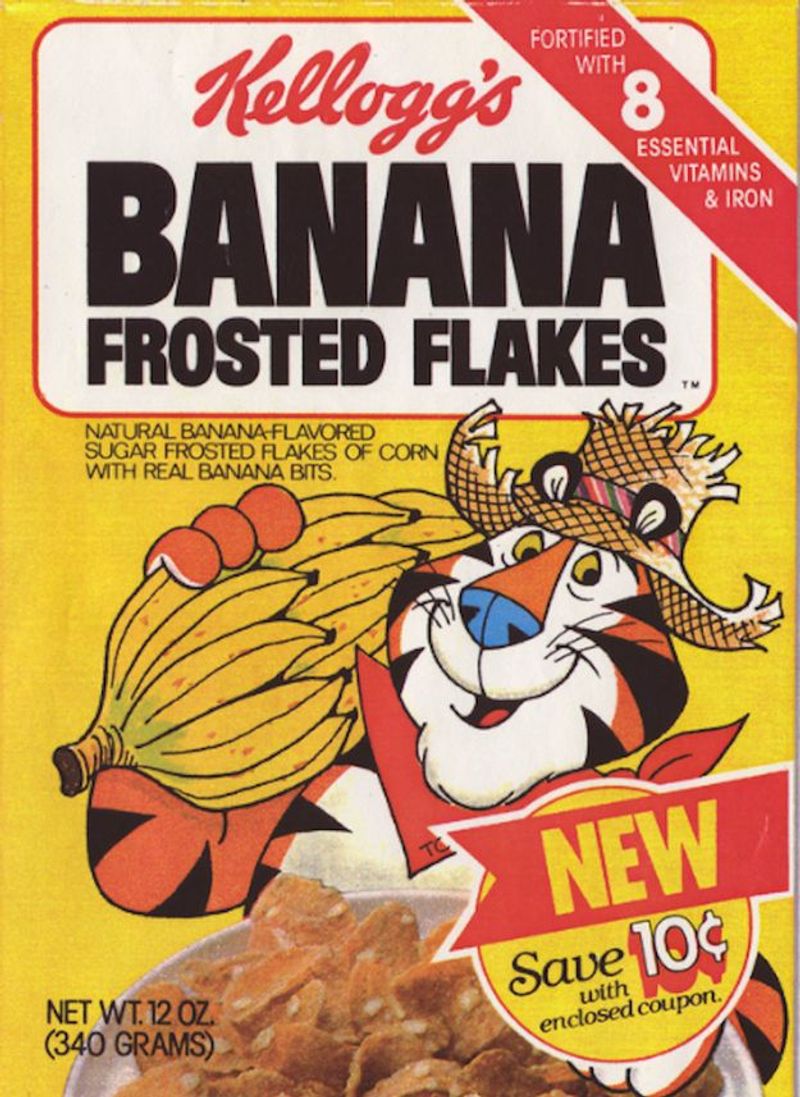
Kellogg’s took their iconic Frosted Flakes to tropical new heights in the late 1980s with Banana Frosted Flakes. The familiar corn flakes and frosting got a banana-flavored twist that created a perfect harmony of fruity and sweet – like having banana cream pie for breakfast.
Tony the Tiger sported a tropical shirt on these bright yellow boxes, declaring them “More than good, they’re gr-r-reat!” The banana flavor wasn’t subtle either; it delivered a bold, almost candy-like banana taste that kids adored.
Despite initial popularity, this tropical variation disappeared after a brief run, joining the graveyard of fascinating breakfast experiments.
20. Mug-O-Lunch
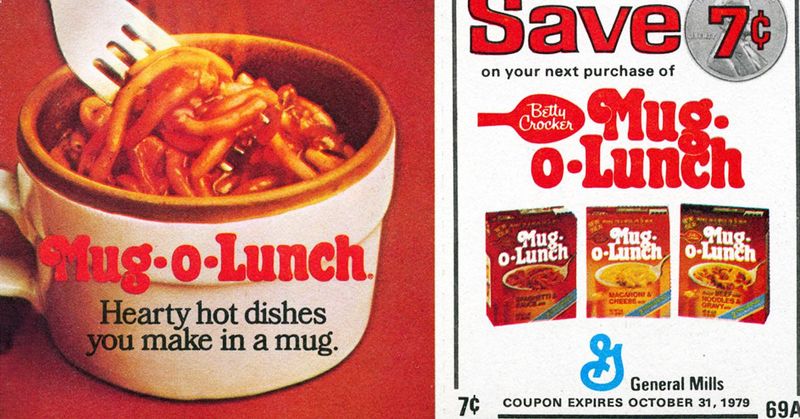
Long before Cup Noodles became a college staple, there was Mug-O-Lunch – the original microwavable meal in a cup. These single-serve wonders from the 1970s came in varieties like Macaroni & Cheese, Noodles & Beef, and Spaghetti & Meatball Sauce, delivering hot comfort food in minutes.
The concept was revolutionary: just add hot water, stir, and enjoy a complete meal from a paper cup. No cooking skills required! They were perfect for kids coming home from school or busy parents needing a quick lunch solution.
These convenient cups disappeared by the early 1980s, ahead of their time in the single-serve revolution that would come years later.
21. Hickory Farms Chocolate Bars
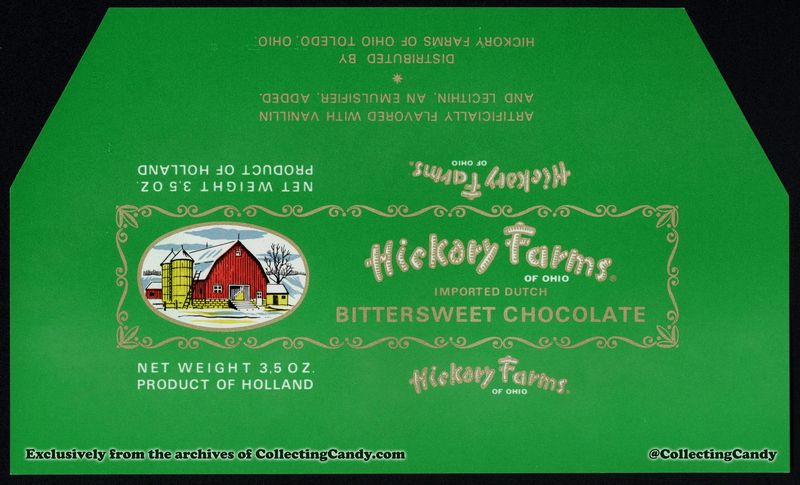
Before Hickory Farms became exclusively associated with holiday sausage and cheese gift sets, they produced some of the most unique chocolate bars of the 1970s and early 1980s.
These specialty chocolate bars came in distinctive flavors like Amaretto, Orange Brandy, and Hazelnut. The bars were wrapped in elegant foil packaging and often included as the sweet finale in their famous gift baskets.
Their mall kiosks would offer samples, creating a Pavlovian response in shoppers whenever they passed by. As the company shifted focus to their meat and cheese products, these sophisticated chocolate treats gradually disappeared, leaving behind nostalgic memories of mall shopping in simpler times.
22. Dinky Donuts Cereal
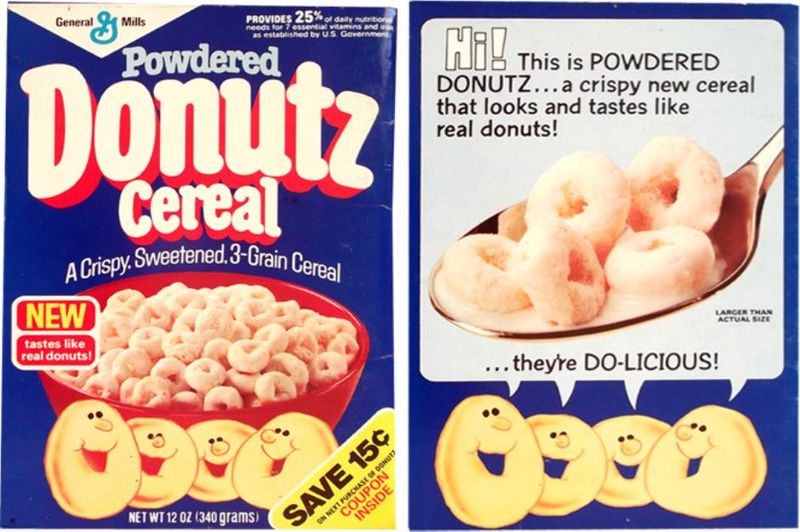
Breakfast became dessert in 1980 when Post introduced Dinky Donuts cereal – tiny donut-shaped pieces that genuinely tasted like powdered sugar donuts.
Unlike many cereals that merely hinted at their inspiration, these little rings delivered authentic donut flavor in every bite. The commercials featured animated mini-donuts performing synchronized swimming routines in milk.
Kids were drawn to both the playful marketing and the novelty of eating donuts for breakfast with parental approval. Despite their popularity, Dinky Donuts disappeared after just a few years, though their influence can be seen in the donut-shaped cereals that followed decades later.
23. Oreo Big Stuf

The year was 1984, and Nabisco decided regular Oreos weren’t enough – America needed a massive, individually-wrapped Oreo the size of a small hamburger. Thus, Oreo Big Stuf was born, weighing in at a whopping 316 calories per cookie.
These enormous treats featured the same familiar chocolate cookie and cream filling but scaled up to impressive proportions. Kids would spend entire recesses working through just one cookie, making them a lunchbox status symbol.
Despite their popularity, growing health consciousness in the 1990s likely contributed to their discontinuation after about seven years – though their memory looms large in snack history.
24. Space Food Sticks
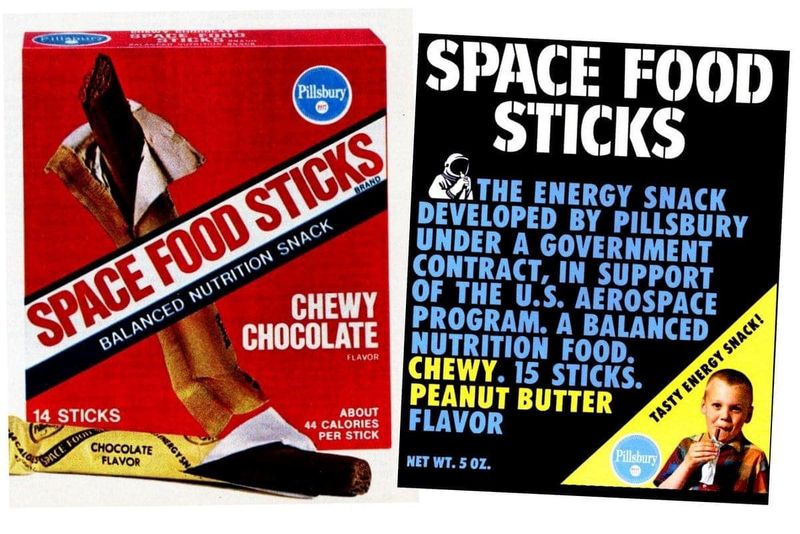
Long before energy bars lined supermarket shelves, there were Space Food Sticks – the snack literally developed for astronauts.
Created by Pillsbury in the 1960s to feed astronauts in space, these chewy, cylindrical treats were marketed to kids as futuristic energy snacks during the height of America’s space obsession. Available in flavors like chocolate, peanut butter, and caramel, these bendable, shelf-stable sticks came individually wrapped in air-tight packages.
The marketing brilliantly tapped into space-age excitement, promising the same nutrition consumed by actual astronauts. They gradually disappeared from American stores by the late 1980s, though they maintained popularity in Australia for years longer.
25. Jell-O 1-2-3
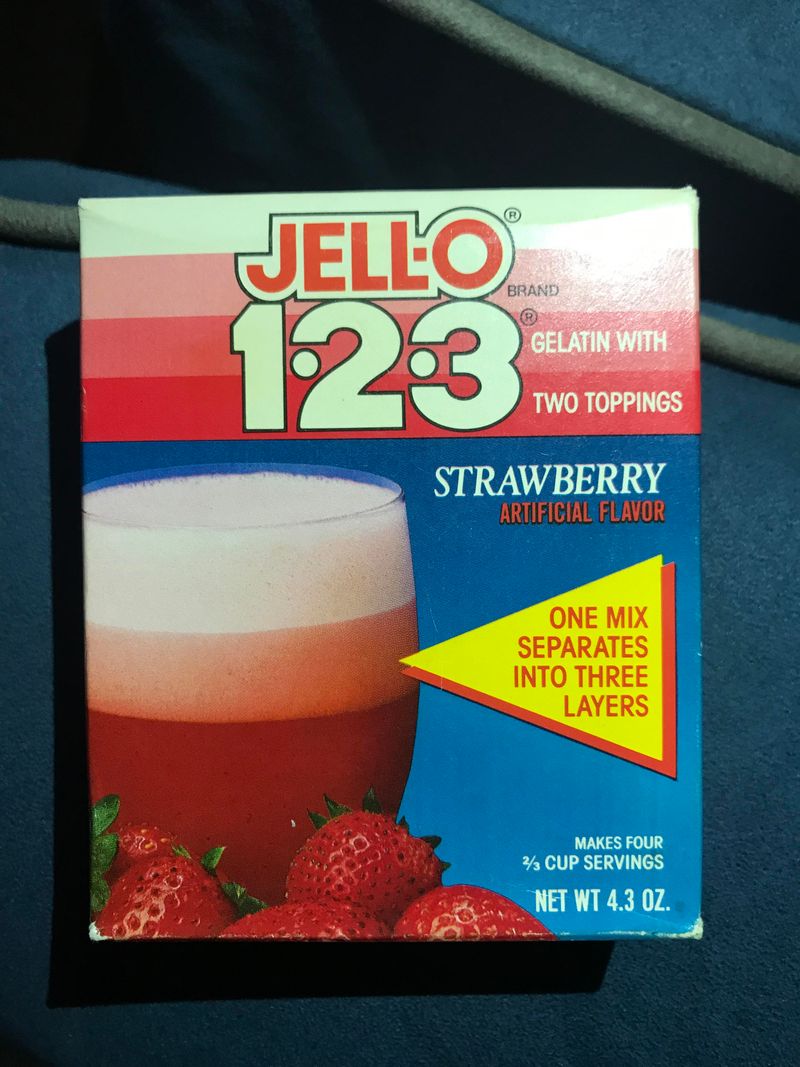
Kitchen magic happened when you prepared Jell-O 1-2-3, a dessert mix that separated into three distinct layers while setting in the refrigerator. The bottom layer was classic Jell-O, the middle transformed into a creamy mousse, and the top became a light, airy foam – all from one simple mix.
Introduced in 1969 and popular throughout the ’70s and ’80s, this dessert was a showstopper at dinner parties. The scientific process fascinated kids, who would watch through clear glasses as the layers formed.
Despite devoted fans, General Foods discontinued this marvel in 1996, leaving home cooks to attempt multi-step recreations that never quite captured the original’s simple elegance.
26. Smurf Berry Crunch Cereal
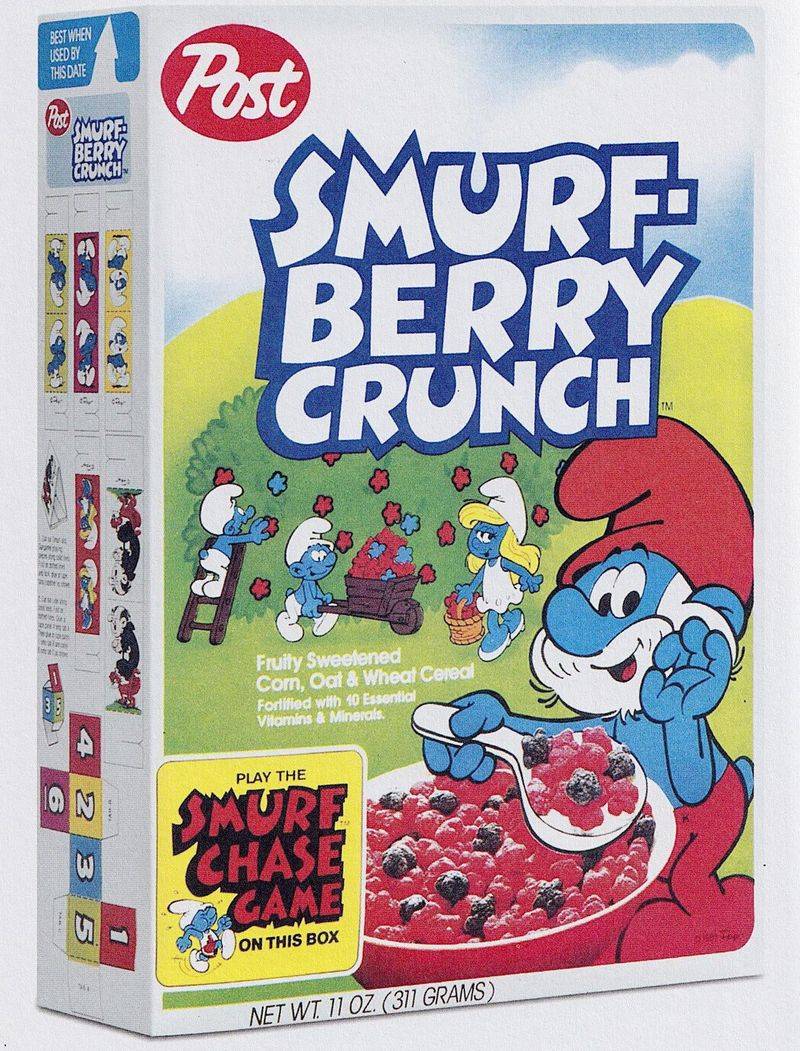
When tiny blue cartoon characters dominated Saturday mornings in the 1980s, Post cereal capitalized with Smurf Berry Crunch. This red and blue berry-flavored cereal turned milk a magical shade of purple-blue, delighting kids across America.
The box featured Papa Smurf and other characters from the popular cartoon gathered around bowls of cereal. The sweet, fruity taste and color-changing milk made breakfast an adventure rather than a chore.
Introduced in 1983 and discontinued by 1987, the cereal has achieved cult status among ’80s kids who remember the thrill of pouring blue milk from their cereal bowls.
27. Mr. T Cereal
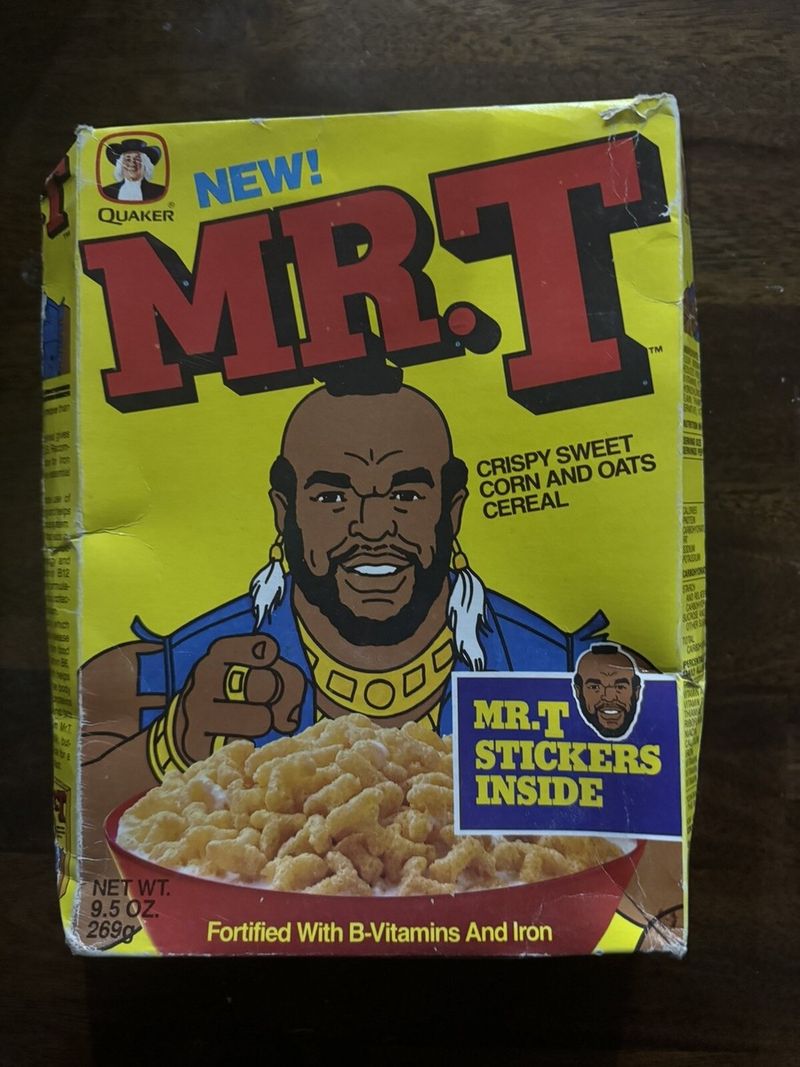
“I pity the fool who doesn’t eat my cereal!” In 1984, Quaker Oats capitalized on A-Team fever by creating a sweet corn and oat cereal shaped like the letter T. Mr. T Cereal brought the mohawked, gold-chain-wearing action star directly to breakfast tables across America.
The cereal’s sweetened corn and oat pieces were similar to Cap’n Crunch but with the novelty of T-shaped pieces. The box featured Mr. T in his signature outfit, flexing and encouraging kids to eat right.
Like many celebrity-endorsed foods, this cereal vanished once the star’s popularity waned, but remains a perfect time capsule of 1980s pop culture.
Leave a comment